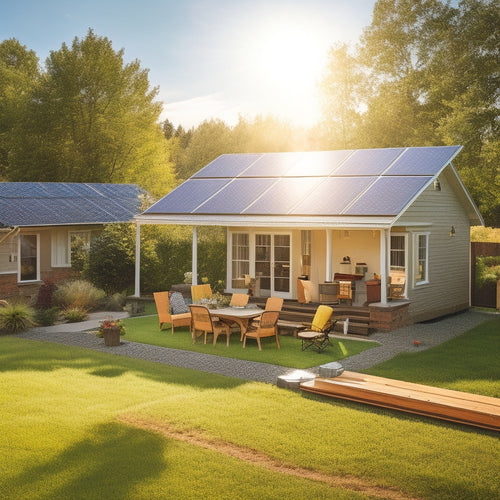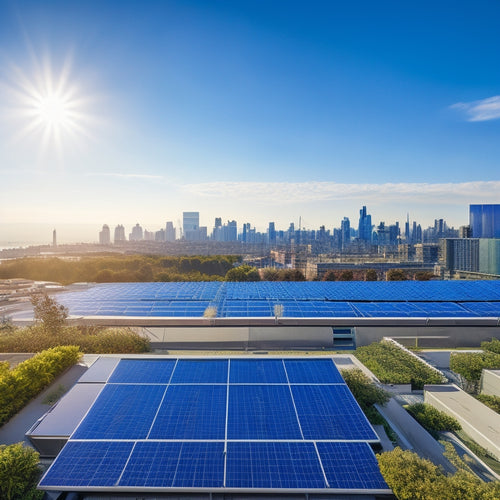
Boosting Commercial Energy Efficiency With Real-Time Monitoring
Share
By implementing real-time monitoring, you can pinpoint areas of inefficiency, optimize energy usage, and make data-driven decisions to boost commercial energy efficiency. You'll identify energy-intensive areas, track energy output, and receive alerts for unusual consumption patterns. With real-time monitoring, you'll optimize solar panel performance, identify energy wastage patterns, and develop a roadmap for improvement. You'll make data-driven decisions to minimize energy waste, refine energy management strategies, and optimize energy consumption patterns. As you explore the benefits of real-time monitoring, you'll uncover more ways to maximize energy efficiency and reduce energy costs.
Key Takeaways
• Real-time energy monitoring helps identify areas of inefficiency, enabling data-driven decisions for energy optimization and contributing to grid stability.
• Implementing real-time energy usage alerts detects energy spikes, equipment failures, and energy drift, allowing for prompt corrective action.
• Optimizing solar panel efficiency through real-time monitoring and benchmarking ensures maximum energy harvest and minimizes energy waste.
• Identifying and addressing energy wastage patterns through energy mapping and auditing helps prioritize improvements and yields significant energy savings.
• Data-driven energy optimization strategies, such as predictive modeling and load profiling, refine energy management and minimize energy waste.
Real-Time Energy Output Tracking
You can track your commercial building's energy output in real-time, allowing you to identify areas of inefficiency and opportunities for improvement.
With real-time monitoring, you'll have a thorough understanding of your energy consumption patterns, enabling data-driven decisions to optimize energy usage. This level of visibility is crucial for energy forecasting, as it helps you predict energy demands and adjust your energy strategy accordingly.
Additionally, it contributes to grid stability by ensuring a balanced energy supply and demand. By analyzing your building's energy output in real-time, you'll be able to pinpoint energy-intensive areas and implement targeted improvements, resulting in significant energy savings and a reduced carbon footprint.
Maximizing Solar Panel Efficiency
When it comes to maximizing solar panel efficiency, you'll want to focus on optimizing three key areas.
First, you'll need to confirm that your panels are installed at the best tilt and angle to capture the most sunlight.
From there, you can implement panel cleaning schedules and track inverter performance to squeeze every last watt out of your system.
Optimal Tilt and Angle
By adjusting the tilt and angle of solar panels, commercial buildings can maximize energy harvest and reduce their reliance on non-renewable energy sources. You must consider the structural integrity of your building and the angular momentum of the panels to guarantee peak energy production. The ideal tilt and angle vary depending on your location and the time of year.
| Latitude | Best Tilt | Best Angle |
|---|---|---|
| 0°-23.5° | 10°-20° | 0°-15° |
| 23.5°-35° | 20°-30° | 15°-30° |
| 35°-50° | 30°-40° | 30°-45° |
| 50°-90° | 40°-50° | 45°-60° |
Panel Cleaning Schedules
Maximizing solar panel performance requires a rigorous cleaning schedule, as even a thin layer of dirt or debris can greatly reduce energy output, making it crucial to establish a regular maintenance routine to maximize energy efficiency.
You need to stay on top of dust accumulation, which can be a significant issue in dry or windy areas.
To guarantee peak performance, consider the following seasonal maintenance schedule:
-
Weekly inspections: Quickly inspect panels for visible debris or dust.
-
Bi-monthly cleaning: Clean panels with a gentle cleaning solution and soft brush.
-
Quarterly deep cleaning: Use a more intense cleaning solution and scrub brush for tough debris.
- Annual inspection and maintenance: Perform a thorough inspection and maintenance routine, including panel cleaning, tightening, and electrical checks.
Inverter Performance Tracking
You can greatly enhance your solar panel efficiency by monitoring your inverter's performance in real-time, enabling you to verify and address any issues promptly. By tracking key performance indicators such as DC power output, you can optimize energy harvest and maximize your return on investment.
Real-time monitoring also allows you to guarantee grid compliance, avoiding penalties and fines associated with non-compliance. With real-time data, you can pinpoint underperforming inverters, identify trends, and make data-driven decisions to improve overall system efficiency.
Identifying Energy Wastage Patterns
As you implement real-time monitoring in your commercial building, you'll uncover wasteful usage patterns that are silently draining your energy resources.
You'll pinpoint energy drain hotspots, such as inefficient lighting systems or outdated HVAC units, that are driving up your energy bills.
Wasteful Usage Patterns
Identifying wasteful usage patterns is critical, since they can account for up to 30% of a commercial building's total energy consumption, with issues like overheating, overcooling, and simultaneous heating and cooling being common culprits. As you monitor your building's energy usage, you'll likely uncover patterns that are draining your resources.
Here are some common wasteful usage patterns to look out for:
-
Energy leaks: Equipment or systems that continue to draw power even when turned off or in standby mode.
-
Idle loads from devices like computers, printers, and appliances that remain on even when not in use.
-
Simultaneous heating and cooling: HVAC systems working against each other, wasting energy and increasing your bill.
- Inefficient lighting: Using outdated or inefficient lighting technologies that consume more energy than necessary.
Energy Drain Hotspots
By pinpointing energy drain hotspots, commercial buildings can uncover hidden areas of wastage, where inefficient systems, outdated technologies, and poor operating practices converge to squander valuable energy resources.
You can identify these hotspots through energy mapping, which involves tracking energy consumption patterns across various building systems. This process helps you pinpoint areas of inefficiency and prioritize improvements.
Energy Drain Hotspot: Lighting Systems
Description: Inefficient lighting technologies, poor lighting schedules
Cost Analysis: 20% energy savings potential
Energy Drain Hotspot: HVAC Systems
Description: Inefficient equipment, inadequate maintenance
Cost Analysis: 15% energy savings potential
Energy Drain Hotspot: Plug Loads
Description: Unnecessary device usage, inefficient devices
Cost Analysis: 10% energy savings potential
Data-Driven Energy Savings Strategies
You can access significant energy savings by leveraging real-time data to inform your energy management strategy, which typically yields a 10-20% reduction in energy consumption. By analyzing real-time data, you can identify areas of inefficiency and optimize your energy usage.
Here are some data-driven strategies to consider:
-
Energy Auditing: Conduct regular energy audits to identify energy-intensive areas and opportunities for improvement.
-
Predictive Modeling: Use historical data and machine learning algorithms to predict energy usage patterns and optimize your energy management strategy.
-
Load Profiling: Analyze real-time data to identify peak energy usage periods and optimize your energy consumption accordingly.
- Anomaly Detection: Use real-time data to detect unusual energy usage patterns and identify potential issues before they become major problems.
Optimizing Energy Consumption Patterns
To further reduce energy consumption, optimizing energy consumption patterns is key, as it enables you to refine your energy management strategy and make data-driven decisions to minimize waste and maximize efficiency.
By analyzing your energy usage patterns, you can identify opportunities to reduce energy waste and optimize your energy consumption. Conducting regular energy audits helps you identify areas of inefficiency, while load profiling provides a detailed breakdown of your energy usage patterns. This data enables you to pinpoint specific areas for improvement, such as optimizing HVAC systems or lighting schedules.
Energy Efficiency Metrics and KPIs
What metrics and key performance indicators (KPIs) should you track to measure the effectiveness of your energy efficiency initiatives and identify opportunities for further improvement? To gauge your progress, focus on the following key metrics:
-
Energy consumption per square foot: Monitor energy usage in relation to your building's size to identify areas for optimization.
-
Carbon footprint reduction: Track your carbon emissions to measure the environmental impact of your energy efficiency efforts.
-
Energy scoring: Assign a score to your building's energy performance to benchmark and compare with industry standards.
- Energy cost savings: Calculate the financial benefits of your energy efficiency initiatives to justify future investments.
Real-Time Energy Usage Alerts
By leveraging advanced monitoring systems, real-time energy usage alerts enable facility managers to pinpoint anomalies in energy consumption patterns, allowing for swift corrective action to curb energy waste. These alerts foster energy awareness, ensuring that you're always informed about your energy usage. However, striking a balance between informative alerts and alert fatigue is crucial, which can lead to desensitization.
| Alert Type | Description |
| Energy Spike | Unusual increase in energy consumption |
| Equipment Failure | Malfunctioning equipment causing energy waste |
| Energy Drift | Gradual increase in energy consumption over time |
| Baseline Exceedance | Energy usage exceeds expected baseline |
Solar Panel Performance Benchmarking
You can optimize your solar panel performance by tracking key performance indicators (KPIs) such as energy output, temperature, and irradiance, enabling data-driven decisions to maximize returns on investment. This allows you to identify underperforming panels and take corrective action.
Here are four essential metrics to track for peak performance:
-
Energy Output: Monitor energy production in real-time to detect anomalies and enhance performance.
-
Temperature: Track temperature fluctuations to maintain ideal operating conditions.
-
Irradiance: Monitor solar irradiance to adjust panel angles and maximize energy harvest.
- Inverter Efficiency: Ensure inverter efficiency aligns with industry standards, such as Solar Certifications and Energy Standards, to optimize energy production.
Energy Efficiency Improvement Roadmap
Developing an energy efficiency improvement roadmap allows your organization to prioritize and implement targeted initiatives, ensuring a structured approach to achieving peak energy performance. This roadmap serves as a guide for energy auditing, identifying areas of inefficiency, and outlining strategies for facility upgrades. By establishing clear goals and timelines, you can allocate resources effectively and track progress.
| Energy Efficiency Initiative | Implementation Timeline | Expected Savings |
| Conduct energy audit | Q1-Q2 | 10% reduction in energy consumption |
| Install LED lighting | Q2-Q3 | 5% reduction in energy consumption |
| Upgrade HVAC system | Q3-Q4 | 15% reduction in energy consumption |
| Implement smart building technologies | Q4-Q1 | 8% reduction in energy consumption |
| Conduct regular energy monitoring | Ongoing | Continuous optimization and improvement
Frequently Asked Questions
Can Real-Time Monitoring Systems Be Integrated With Existing Building Management Systems?
You can integrate real-time monitoring systems with existing building management systems through seamless system integration, enabling data visualization and centralized control, allowing you to optimize energy efficiency and make data-driven decisions.
How Long Does It Take to See Energy Efficiency Improvements After Implementation?
You'll see energy efficiency improvements within 3-6 months of implementation, with a 15% average energy savings rate. Your implementation timeline will be marked by efficiency milestones, with performance benchmarking helping you hit improvement thresholds.
Are There Any Cybersecurity Risks Associated With Real-Time Energy Monitoring Systems?
When you implement real-time energy monitoring systems, you're exposed to network vulnerabilities, so make sure you prioritize data encryption to prevent cyber attacks and system hacking, safeguarding your energy efficiency gains from potential threats.
Can Real-Time Monitoring Be Used for Energy Efficiency in Residential Buildings Too?
You can totally leverage real-time monitoring to optimize energy efficiency in your home, by leveraging home automation systems that track and adapt to your energy habits, helping you make informed decisions to reduce your carbon footprint.
What Is the Average ROI for Investing in Commercial Energy Efficiency Monitoring Systems?
You'll typically see an average ROI of 15-20% when investing in commercial energy efficiency monitoring systems, yielding significant energy savings and substantial cost benefits, often within 2-5 years, depending on system complexity and implementation.
Related Posts
-

Steps to Prepare for Solar Installation
To prepare for solar installation, start by evaluating your current energy consumption and future needs to determine ...
-

High-Performance Energy-Efficient HVAC Systems
High-performance energy-efficient HVAC systems are essential for reducing energy consumption while improving indoor c...
-

Business Solar Investments for Cost-Effective Sustainability
Investing in solar energy is a smart move for your business, providing a solid foundation for cost-effective sustaina...


